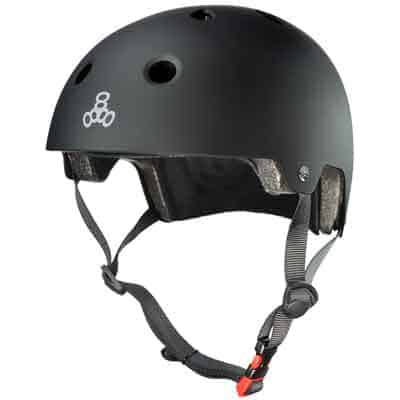If you were beginning your bicycle, three-wheeler, or four-wheeler ride, I’d like to assume you’d wear a helmet. Hoverboard etiquette should be no different. Safety is of the utmost importance to enjoy the best experience when riding. The most important part of safety when riding is the helmet. The helmet protects your most important body part, your head, from injury caused by fall or impacts with other objects you might find at head-level such as branches, signs, or vehicles.
Best Hoverboard Helmets
Image | Model | Features | Check Price |
Best Value | Triple Eight Dual Certified |
| |
Best Looking | Thousand Helmet |
| |
Best LED | Lumos Matrix |
|
What is the Best Hoverboard Helmet?
My top pick for helmets is the Triple 8 Dual Certified. As the name suggests it is in fact dual certified, however it also holds two other certifications as well. As such, it shouldn’t be a big surprise that the helmet has become one of the most popular helmets among skaters, BMX bikers, and hoverboarders alike. Additionally, it is ranked among some of the best helmets on the market.

Check out the “Triple 8 Dual Certified” on Amazon
Why do we need a Helmet when riding Hoverboards?
A good rule of thumb to practice consistently when riding is to put your helmet on every single time. Similarly to your instinctive seat-belt buckling when you first get into a car, you should instinctively snap on that helmet before you begin every ride. Some people think helmets may make you look dorky or nerdy, but I assure you it’s much better than losing your mental processing power to become a vegetable in a wheelchair, or worse, dying. Mistakes happen all the time, anywhere. Remember, you can reach dangerous speeds on your hoverboard and you’re at the will of the terrain. Cultivating the positive habit of protecting your noggin is more than worth the minuscule amount of time and effort it would take to do so. This habit might just save your life one day.
Let’s take a look at some hoverboard helmets!
Best Helmets for Hoverboards
Half-shell helmets allow you to enjoy the cool breeze in your flowing locks of hair. These helmets look and feel retro and because they don’t cover the entire head, they’re the lightest type of helmet. Half-shell helmets don’t protect your entire face but are more versatile when it comes to vision and ventilation.
Helmet Certifications:
| CPSC Standard | EN 1078 | ASTM F1492 | AS/NZS 2063 | MIPS Available | |
|---|---|---|---|---|---|
| Triple 8 Dual Cert | ✓ | ✓ | ✓ | ✓ | |
| Thousand Helmet | ✓ | ✓ | ✓ | ||
| Pro-Tec Classic Cert | ✓ | ✓ | ✓ | ✓ |
Triple 8 Dual Certified
Dual certified suggests this helmet is certified only twice, when in fact the Triple 8 is certified a total of four times: twice for riding and twice for skating. This helmet complies with US CPSC Safety Standards for Bicycle Helmets for Persons of Age 5 and Older, and ASTM F-1492-08 Safety Standards for Skateboarding. This helmet takes Triple 8’s extensive knowledge of helmet design and implements it into the classic half-shell shape. One of the models comes with the patented MIPS Technology low-friction layer, which reduces rotational forces caused by angled impacts. It’s worth the reduced chance of injury.

Complies with CE EN 1078 – Helmets for pedal cyclists, skateboarders, and roller skaters and with AS/NZS 2063 – Bicycle Helmets
Price: $29 – $100 (size and MIPS included dependant)
Check the price here on Amazon.
| Pros: |
| + 4 certifications, guaranteeing premium protection |
| + MIPS available |
| + Available in several colors |
| Cons: |
| – Sometimes too small (better size up) |
SIZE CHART – To ensure a perfect fit, measure the circumference of your head starting in the middle of your forehead and match it with the sizes below.
| Size | inch | cm |
| XS/S | 19.7 – 21.5 in | 50 – 55 cm |
| S/M | 21.5 – 22.75 in | 55 – 58 cm |
| L/XL | 22.75 – 24 in | 58 – 61 cm |
Thousand Helmet
The Thousand is an extremely light helmet, ranging from 410g to 490g and is built to meet CPSC, CE EN 1078 and ASTM F1492 Safety Standards. The default package comes with two sets of extra interior padding to help with custom fitting as well as a secret pop-lock for locking your helmet with your hoverboard.
It’s lightweight, stylish, and well certified without compromising the safety.

Price: $90
Check this model here on Amazon.
| Pros: |
| + Triple certified |
| + Pop-hole for locking |
| + Good Looking |
| + Lightweight |
| Cons: |
| – Poor Ventilation |
| – Pricey |
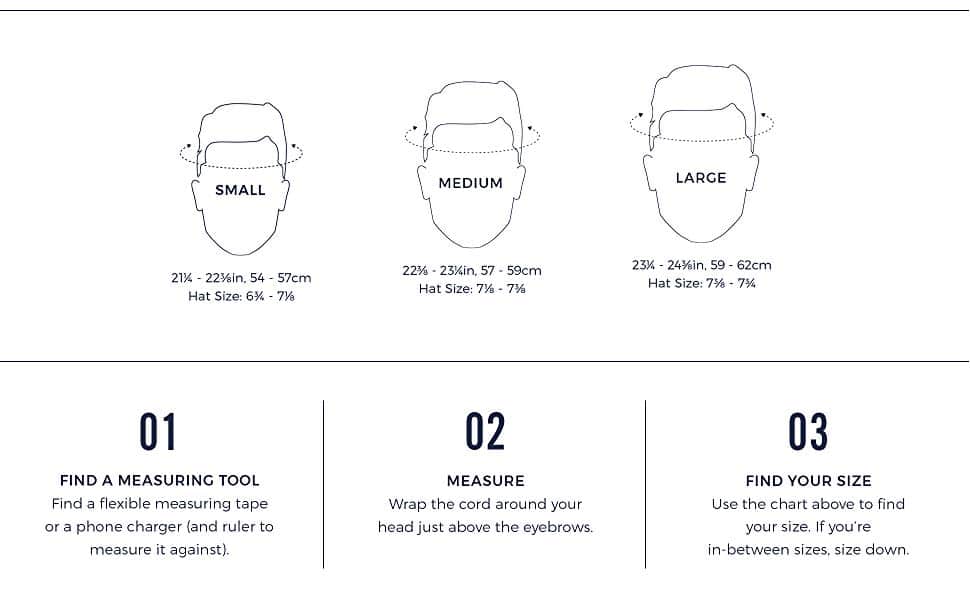
If you can’t choose a size this way, the company recommends taking the smaller size closest to yours.
Pro-Tech Classic Cert Helmet
The Pro-Tec helmet has ESP certified lining to pass ASTM F1492 standards. It comes in a large variety of sizes and is cited as a good option for riders with larger heads. With adjustable straps and compression-molded liner pads, this helmet contains decades of Pro-Tec’s experience in helmet manufacturing which leads to its style and comfort.
The helmet passes safety certifications for CPSC, CE, ASTM, and AS/NZS. 2063:2008.
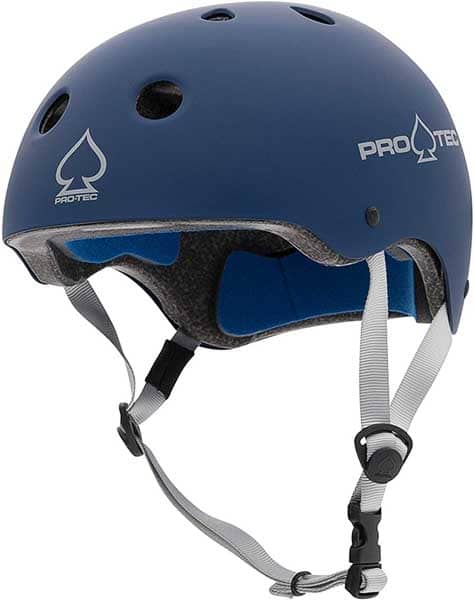
Price: $40–$65
Check it out here on Amazon.
| Pros: |
| + Multi-Certified |
| + Stylish |
| + 8 Air Vents |
| Cons: |
| – Some users report deteriorating liner pads |
| – Users report finding issue with lack of adjustment to the helmet |
Helmets With Integrated LED’s for Night riding on Hoverboard
Helmets with LED lights have improved rider visibility in poor conditions and nighttime riding becomes safer with integrated LED lights on both the front and back of the helmet.
LED Helmet Certifications:
| CPSC Standard | EN 1078 | ASTM F1492 | AS/NZS 2063 | MIPS Available | |
|---|---|---|---|---|---|
| Lumos Matrix | ✓ | ✓ | ✓ | ✓ | ✓ |
| Lumos Street | ✓ | ✓ | ✓ | ✓ | ✓ |
| Lumos Kickstart | ✓ | ✓ | ✓ | ✓ | ✓ |
Lumos Matrix
The newly upgraded Lumos helmet is widely popular with a bigger LED panel on the back of the helmet which you can even use to program your backlighting modes. The Matrix has handlebar-mounted wireless turn indicators and a 10 hour battery life all while weighing only 580g! That’s extremely lightweight considering all the tech and safety features included. The helmet can also connect to a Lumos app to share data with Apple Health/Google Fit. Check it out on their website.
If somehow you aren’t impressed yet, Lumos helmets also carry four safety certifications: CPSC/F1492/EN1078/AS2063 so rest assured, you can ride easy with confidence.
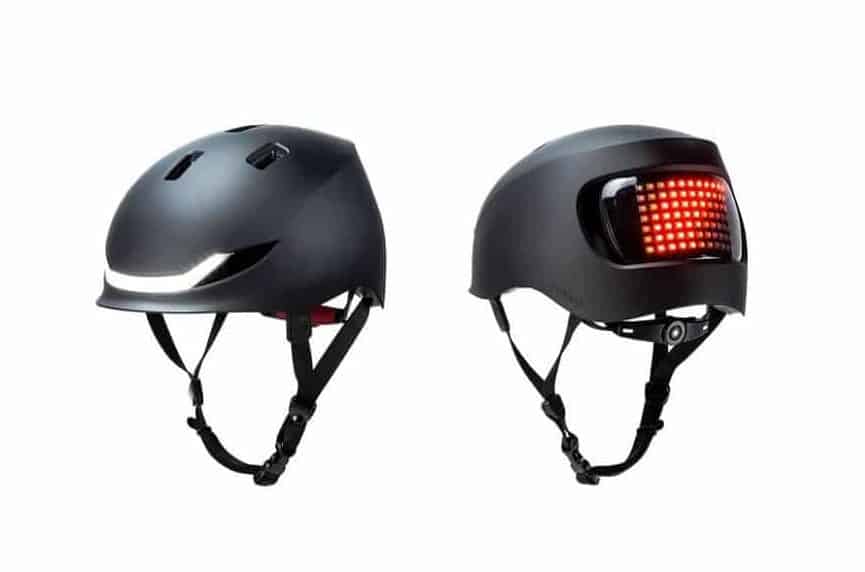
Price: $270 – $290
Check it out here on Amazon.
| Pros: |
| + Multi-Certified |
| + Stylish |
| + Front and Rear LEDs |
| + Turn Signal Indicator |
| + MIPS available |
| Cons: |
| – Expensive |
Lumos Street
The Lumos Street is a bit less complex than the Matrix and it only has three LED stripes integrated into the back of the helmet. White LEDs take the front and red ones take the back, both increasing your visibility and safety dramatically. Not only this, but accelerometers built into the helmet detect acceleration and braking. This means you’ll have working brake lights on the back of your helmet to glow red when you decelerate. Turns have the ability to be indicated by blinking arrows, which point in the direction of the intended turn. This helmet has received an excess of positive reviews and is a favorite in the community. Check them out here.

Price: $220 – $240
Check it out here on Amazon.
| Pros: |
| + Multi-Certified |
| + Stylish |
| + Front and Rear LEDs |
| + Turn Signal Indicator |
| + MIPS available |
| Cons: |
| – Expensive |
Lumos Original
The Lumos Original has LED lights on the front and back just like the previous helmets. These bright red and white lights will guarantee a safer ride. Just like the Street, it has built-in accelerometers to give you functioning brake lights on the back. You can also indicate your turns with working blinkers that point in the chosen direction. It’s loved by most customers, brandishing great reviews once again. Check this helmet out here.
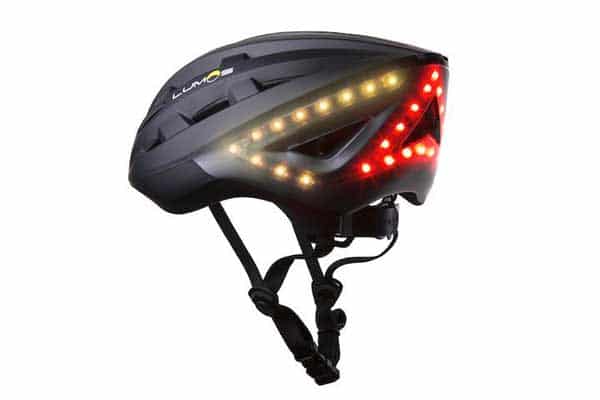
Price: $160 – $180
Check it out here on Amazon.
| Pros: |
| + Multi-Certified |
| + Front and Rear LEDs |
| + Turn Signal Indicator |
| + MIPS available |
| Cons: |
| – Expensive |
Things to Consider Before Buying a Hoverboard Helmet
There are several key factors to think about when choosing a helmet wear while riding your hoverboard. Impulse buying can’t happen for a helmet purchase. You’ll need to know specifically how your helmet fits to these factors. The bottom line is that helmets are necessary and must be completely safe for the user to wear.
- Size and fit: Seeing as your helmet is your first line of defense for attacks against your skull, it is very importantthat your helmet fits well and feels comfortable. Other hats may not be specifically worn and may be adjusted for stylization, but your helmet should sit square on your head, preferably covering the most of your skull without affecting comfort or visibility.
- Chart measurments: Hopefully you’ve already measured the circumference of your head, so you can now begin shopping online for a helmet. For that, you just need to pay attention to the size charts provided.
- Tips for the perfect fit: Expensive helmets aren’t always comfortable. To ensure your helmet fits perfectly, you should primarily adjust the width. This is generally done with an alterable strap.
- Check your chin strap: Ideally, your helmet should not shake off of your head nor come loose if you bend over without closing the chin strap. Now we can adapt this strap, which should run flat and flush against the face to pass the ears and connect at the chin. One finger should fit between the strap and your chin when the buckle is closed and the chin strap is adjusted properly. Hopefully this is obvious, but an adjusted and strapped chin strap should keep the helmet from being pulled off of your head.
- Safety standards: Unless you’re a super hero (in which case can I have your number?), you only have one brain. Seriously though, brain damage is no joke and can change your life from riding hoverboards to drooling like a vegetable in a wheelchair as quick as you read this sentence. Please, invest in the safest helmet you can reasonably get. The protection quality of a helmet is indicated by Certified Safety Standards, which feature impact ratings. A helmet’s outer shell is generally made of polycarnonate plastic aka kevlar or fiberglass. The core is typically polystyrene or polypropylene foam, which crushes on impact. This process absorbs the shock that would have otherwise been absorbed in your skull. So, after an impact, it won’;t be able to provide the same level of protection even if it looks like it’s still in good condition. Dropping your helmet can do this same thing, so be careful. The hard grey or black foam inside a helmet must be certified by CPSC standards. An EPS certification doesn’t necessarily mean the helmet is certified, so watch out for that. Certification standards may differ accross national and international zones, but some standards are accepted across multiple ones. Here are a few of the World Certifications and Certifying bodies:
- AS/NZS – Standards Australia and Standards New Zealand
- ASTM – American Society for Testing and Materials International
- CPSC – U.S. Consumer Product Safety Commission
- CSA – Canadian Standards Association;
- DOT – Department of Transportation;
- EN – Euro-norm or European Standard from the European Committee for Standardization;
- Snell – Snell Memorial Foundation.
- You will likely come across these certifications:
- CPSC Standard: Safety Standard of “The United States Consumer Product Safety Commission” for Bicycle Helmets
- ASTM F1492: Standard specification for helmets used for Bicycling, Skateboarding, Trick Roller Skating
- ASTM F1952: Safety Standard for Downhill Mountain Bicycle Helmets
- ASTM F1447: Safety Standard for bicycle helmets
- Snell N-94: This Standard describes helmets for use in non-motorized sports which includes bicycling. Helmets certified to this Standard, by the fact of this certification, have met all the requirements for the Snell Memorial Foundation’s Standard for bicyclist helmets. The Snell Memorial Foundation, Inc. is a not-for-profit organization dedicated to research, education, testing and development of helmet safety standards.
- EN 1078: European Safety Standard for Helmets for pedal cyclists, skateboarders, & roller skaters
- AS/NZS 2063: Australian/New Zealand Safety Standard for Bicycle helmets.
IMPORTANT! Make sure at the LEAST that the helmet has the weakest certification. The bare minimum is the ATSM F1492 certification for helmets.
- New vs. Second Hand: As with lots of sporting markets, there is one for used parts, accessories, and add-ons. However, used safety gear is a definite mistake! Especially when shopping for a helmet, this gear cannot be trusted. Heaven knows what you’d be poking your head into, and you won’t know if this helmet has already weakened the integrity with a fall. Get a brand new helmet every time. It isn’t worth it.
- Weight: If you’re like me, then you probably aren’t comfortable with a heavy helmet on your head. Not only is it annoying and distracting, but your neck will tire easier requiring more frequent resting periods. When trying out a nww helmet, check the weight given with add-ons included. Think about your average ride now, can your neck take it? Choose carefully, your neck deserves the extra thought. After all, it literally keeps your head up!
- Price: Conventional wisdom says that constantly replacing cheap parts will cost you more than investing in worthwhile gear. You only have one human head, and there’s currently no way to get a new one. Buy a helmet from a recognized brand at a reasonable price to protect your head and you’ll thank yourself later! Good helmets with warranties and certifications are available at a wide range of prices Work with your budget and work up if you need to!
- A half lid helmet will normally set you back $30-90
- A full-face helmet may cost anywhere between $150-400
- Design: Get yourself a helmet you like. The graphics may not protect you in a crash, but you don’t want to find yourself not wearing it because it’s ugly. Also, some graphics may provide additional visibility when luminous or reflective paints are used.
- Climate / Weather: Helmet design should be influenced by your local climate as well. If you’re in a hotter area, get one with more ventillation. In a cooler area one might appreciate extra insulation so your ears don’t freeze. Air vents will be your cooling system and the number of vents will vary between brands. The size and shape of these matter too, so be careful when making a selection.
- Sweat Liners and Hygiene: When you’re riding your hoverboard, you’ll probsblysweat to some degree. Riding around with rivers of sweat down your face and neck isn’t fun, while sweat stinging your eyes could result in a crash. A good sweat liner helps to minimize the amount of sweat that runs down your face during a ride. Another thing to take note of is that sweat liners should be replaced regularly to prevent bacteria buildup. Plus, they get straight stinky. Get a helmet that’s easy to clean so you don’t find yourself wearing an insect infested helmet.
When should I replace my Hoverboard Helmet?
Helmets are built to protect the head and therefore are pretty durable. Though it doesn’t take full destruction to require replacement. Most manufacturers recommend replacing a helmet when it has endured a substantial hit, compromising the integrity of the helmet and therefore lessening safety.
Should I Replace a Helmet After Dropping It?
Generally speaking, no, you don’t have to. Helmets are designed to be quite resilient and don’t usually get busted after an accidental drop. However, frequent dropping or spiking a helmet on the ground may eventually degrade a helmet’s performance. Similarly, if the helmet falls to the ground at highway speeds unoccupied, the owner must be aware of some degradation that probably occured. In general, the real damage comes from helmet impacts while the head is inside it. The impact is transferred to the absorbent material to protect the head, but crushing it in the process. Remember, helmets are one-time use items, even if they may be very durable otherwise.
Summary:
- Did you crash? Replace it.
- Did you somehow drop it hard enough to crack the foam? Replace it.
- Is it from the ’80s? Dude… please just replace it.
- Is it just the outside foam or cloth instead of plastic. Replace it!
- Still can’t get it to fit correctly? I’ll beg you, replace it.
- Do you still like wearing it? If not, it’s time for a new one!
Final Thoughts – Now it’s Your Turn
As the riding world progresses to faster electronic methods of transportation, helmets are essential. Though once regarded as nerdy, this safety accessory might save your life.
All it takes to be part of the new style is to treat your body with respect and care – spread the word!
I hope you enjoyed reading my article. If you have comments or reactions or would like to recommend another helmet, I would be very happy to hear from you in the comments so nowit’s your turn!
Which helmet do you like most and why?
Let me know in the comment section down below!

